Round The World and other travels
A frequent flyer's collection of trip diaries
This is: Northern Spain 2015
Onwards to Aragon
We repeated the previous day's experience of breakfast in the hotel; this time it was considerably less busy and we managed to get a prime window table. Sadly, it was then time to pack up and leave, our stay in the Rioja wine region very nearly at an end.
Logroño
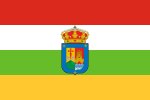 I
took the wheel for the whole of today's journey. Deciding to use a
different route to Logroño than the one on which we had arrived, I
headed north towards Laguardia before turning eastwards. We said a
final farewell to the Basque Country shortly before arriving in our
first stop of the day, and then managed to locate the planned
underground car park adjacent to the city's Old Town area. Logroño
(pop. 150,000) is the capital city of the autonomous Spanish region of La
Rioja. While common sense suggested that a city with this status
would contain some sights of interest to travellers, more detailed
research had led to the conclusion that a relatively short visit
would suffice.
I
took the wheel for the whole of today's journey. Deciding to use a
different route to Logroño than the one on which we had arrived, I
headed north towards Laguardia before turning eastwards. We said a
final farewell to the Basque Country shortly before arriving in our
first stop of the day, and then managed to locate the planned
underground car park adjacent to the city's Old Town area. Logroño
(pop. 150,000) is the capital city of the autonomous Spanish region of La
Rioja. While common sense suggested that a city with this status
would contain some sights of interest to travellers, more detailed
research had led to the conclusion that a relatively short visit
would suffice.
And indeed we were able to see all that we wanted to in just an hour of strolling around: the co-cathedral (an alternative seat of the bishop based in Santo Domingo de la Calzada, visited the previous day), the parliament building of La Rioja (an old tobacco factory, remarkably, with its red brick chimney still standing) and the Calle del Laurel and Calle San Juan (both famous for their pincho bars, but we'd only just had breakfast!)
 |
 |
 |
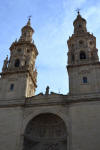 |
 |
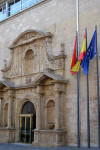 |
 |
 |
 |
Zaragoza
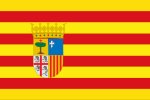 We
managed to find our way out of Logroño fairly easily and had a
similarly stress-free journey to Zaragoza, albeit one involving a
substantial Autopista toll. During the drive, we quickly
left La Rioja, passed through Navarra without stopping, and finally
entered the autonomous community of Aragon (Spanish: Aragón).
We found our way through the streets of its capital and located our
hotel, the NH Ciudad de Zaragoza, without difficulty. The
check-in process was memorable, not because we were given immediate
access to our room, but due to the instruction to ensure that we
parked on Level -1 of the underground garage, as the lower Level -2 had
flooded a few days previously! And indeed, the view from our room
confirmed that the adjacent Río Ebro - the same one that we
had already encountered back in the Rioja wine region - was
alarmingly high and flowing at breakneck speed.
We
managed to find our way out of Logroño fairly easily and had a
similarly stress-free journey to Zaragoza, albeit one involving a
substantial Autopista toll. During the drive, we quickly
left La Rioja, passed through Navarra without stopping, and finally
entered the autonomous community of Aragon (Spanish: Aragón).
We found our way through the streets of its capital and located our
hotel, the NH Ciudad de Zaragoza, without difficulty. The
check-in process was memorable, not because we were given immediate
access to our room, but due to the instruction to ensure that we
parked on Level -1 of the underground garage, as the lower Level -2 had
flooded a few days previously! And indeed, the view from our room
confirmed that the adjacent Río Ebro - the same one that we
had already encountered back in the Rioja wine region - was
alarmingly high and flowing at breakneck speed.
 |
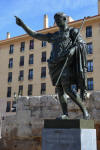 |
 |
| ABOVE and RIGHT: Reminders of the city's origins |
 |
|
| FAR RIGHT: Central Market and an Old Town lunch stop |
After settling into our new quarters, which were rather more basic than those to which we had recently become accustomed, we set out to have some lunch and explore the Old Town, realising as we did so just how well the hotel was located for this purpose. Named after Roman emperor Caesar Augustus, Zaragoza is a city of 700,000 people that was once the final capital of the old Kingdom of Aragon. The compact old town is home to a number of interesting sights, the most prominent of which is the Basílica de Nuestra Señora del Pilar, a Baroque extravaganza dating from the 17th and 18th centuries. The original small chapel on the site, dating from the 1st century AD, is said to have been the oldest Marian church in Christendom. According to legend, the chapel was built by St James in obedience to a request from an apparition of the Virgin Mary herself. Again according to legend, she is said to have left a small pillar that was to be incorporated into the design – hence the name. Today, the building attracts a steady flow of pilgrims as well as tourists. Possibly because the church is so heavily used for devotional purposes, the taking of photographs was not permitted while touring the building.
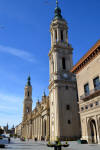 |
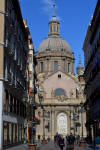 |
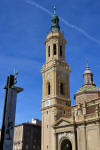 |
 |
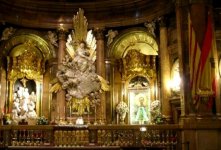 |
|
LEFT and ABOVE:
My photos of the 'Pillar' basilica |
||||
| RIGHT: Stock image of the famous shrine |
Just a short distance away is Zaragoza Cathedral, correctly the Catedral del Salvador (Cathedral of the Saviour), but better known locally as La Seo (“The See”). It is a component of a fragmented UNESCO World Heritage Site known as 'Mudéjar Architecture of Aragon'. The original mosque on the site was destroyed in 1140. Today, the building shares its cathedral status with the 'Pillar' basilica, the latter having been raised to the rank of co-cathedral. Between the two great religious buildings stands the definitely secular, and relatively modern Ayuntamiento (City Hall).
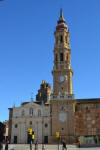 |
 |
LEFT: Zaragoza Cathedral, known locally as La Seo |
 |
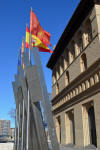 |
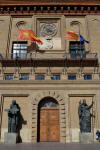 |
| RIGHT: Zaragoza City Hall |
 |
| RIGHT: Some more general views of the Old Town area of Zaragoza |
 |
 |
 |
 |
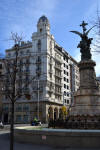 |
 |
 |
 |
 |
| Zaragoza Bullring |
With the main Old Town sights completed, we walked westwards towards the city's bullring and then on to the Palacio de la Aljaferia, one of the most important Moorish buildings in Northern Spain and the setting for Verdi's opera Il Trovatore. While it was interesting to see this building, which in reality looked more like a castle than a palace, we both felt that it hadn't quite lived up to its billing. Walking back to the hotel via the riverbank showed just what a perilous condition the Ebro was in. We could but hope that there would be no need to evacuate the hotel in the small hours, and that we would not make our way to our rental car the next morning, only to find it gently bobbing around in the underground car park!
 |
 |
 |
 |
 |
 |
| ABOVE: Aljaferia Palace | ABOVE: Heavily swollen River Ebro | ||||
Following a short rest in the hotel, we made another foray into the Old Town for drinks and dinner, over which we were able to contemplate another enjoyable day full of interest and variety.